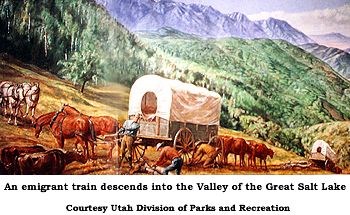
Over the winter, Brigham Young collected travel reports and cross-examined men who had been west along the trail. Thanks to this added information and the previous summer’s experience, the second leg of the journey would be flawlessly executed. Moreover, the 1847 vanguard company would be limited to a handpicked party of 144 men, three wives, and two small boys. They would start in early spring, soon followed by the main body of emigrants. On April 5, the first Mormon wagon train rolled out of Winter Quarters. The well-traveled Oregon Trail crossed Nebraska along the south side of the Platte and North Platte Rivers, but Young kept his company on an old fur-trade trace along the north bank, hoping to avoid clashes with anti-Mormons who might be bound for Oregon or California. As they traveled, the Mormon pioneers made improvements for those to follow. This would be the primary route for Mormon emigrants over the next two decades, and within a few years it also would become the preferred route of non-Mormons heading west. The north-bank trail ended in eastern Wyoming, forcing the Mormon company to cross the North Platte River at Fort John (soon to become Fort Laramie) and merge with the general emigration on the Oregon Trail. From the east approached a fast-moving wagon train from Missouri, the state that had violently expelled the Latter-day Saints in 1838. The race was on! Mormons and Missourians leap-frogged, sometimes helping each other and sometimes competing, as they continued west. Now began the long climb to the Continental Divide in the Rocky Mountains. On June 21 the Mormons paused to clamber up Independence Rock, one of the most famous landmarks on the trail, and offer prayers. Six days later, the third anniversary of the assassinations of Joseph and Hyrum Smith, the company crossed South Pass and continued toward Fort Bridger, a trading post in southeastern Wyoming. There on July 9 the Mormons branched off the Oregon Trail onto the Hastings Cutoff, angling southwesterly toward today’s Utah. The previous year, the California-bound Donner-Reed Party had gone this way and grubbed a new wagon track through the Wasatch Mountains to reach the Salt Lake Valley. (Their labors cost them 18 days, causing them later to become trapped by snow in the Sierra Nevada.) The Mormons followed and improved their track over the most rugged 116 miles of the entire westward journey. Along this stretch of trail, Brigham Young became very ill and fell behind the main company, which entered the Salt Lake Valley two days ahead of him. On July 24, 1847, Young’s carriage rolled into the Mormon camp located in today’s downtown Salt Lake City. His people were already at work digging irrigation ditches and planting crops for the oncoming emigration. From 1847 to 1868, when the transcontinental railroad reached Utah, nearly 70,000 Mormons would follow the trail to the Great Salt Lake Valley. More Mormon Trail History:
|
Last updated: April 23, 2025
